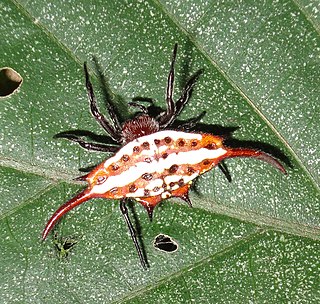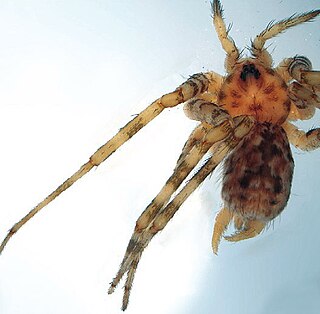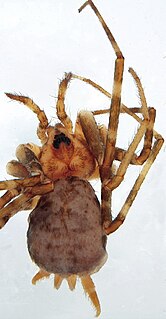
John Blackwall was a British naturalist with a particular interest in spiders.

Thomas Vernon Wollaston FLS was a prominent English entomologist and malacologist, becoming especially known for his studies of Coleoptera inhabiting several North Atlantic archipelagoes. He was well-placed socially. His religious beliefs effectively prevented him from supporting Charles Darwin's theories after 1859, but Darwin remained a close friend. Wollaston supported the theory that continental lands had once extended outward farther to encompass some of the island groups he studied.
Wesolowskana is a spider genus of the family Salticidae. Both described species are endemic to the Cape Verde Islands. The genus should possibly be included in the genus Pseudicius. It was originally named Luxuria when it was first described by Wanda Wesołowska in 1989. It was renamed in 2008 because Luxuria was already in use for a genus of molluscs.
Latrodectus cinctus is a species of spider in the family Theridiidae, found in Cape Verde Islands, Africa, Kuwait and Iran. It is one of six species of Latrodectus found in southern Africa, four of which, including L. cinctus, are known as black button or black widow spiders. Like all Latrodectus species, L. cinctus has a neurotoxic venom. It acts on nerve endings, causing the very unpleasant symptoms of latrodectism when humans are bitten.
Tama novaehollandiae or Tamopsis novaehollandiae are names used for an Australian spider species. However, the original type specimen has been lost, and it is not clear which, if any, of the many species of Tamopsis now recognized the name refers to, so it is treated as a nomen dubium. Tamopsis is placed in the family Hersiliidae.

Gasteracantha versicolor, known as the long-winged kite spider, is a species of diurnal spiny orb-weaver of the family Araneidae. It is found in the tropics and sub-tropics, where it occurs in forests. It has an extensive range, from central, east and southern Africa to Madagascar.

Alireza Zamani is an Iranian arachnologist and taxonomist.

Deltshevia is a genus of Asian tree trunk spiders that was first described by Yuri M. Marusik & Victor R. Fet in 2009. As of May 2019 it contains only two species: D. danovi and D. gromovi.
Duninia is a genus of Asian tree trunk spiders that was first described by Yuri M. Marusik & Victor R. Fet in 2009.

Hersiliola is a genus of tree trunk spiders that was first described by Tamerlan Thorell in 1870.

Ovtsharenkoia is a monotypic genus of Asian tree trunk spiders containing the single species, Ovtsharenkoia pallida. It was first described by Yuri M. Marusik & Victor R. Fet in 2009, and has only been found in Central Asia.
Tyrotama is a genus of African tree trunk spiders that was first described by S. H. Foord & A. S. Dippenaar-Schoeman in 2005.
Pycnacantha is a genus of African orb-weaver spiders first described by John Blackwall in 1865.

Paidiscura is a genus of comb-footed spiders that was first described by Allan Frost Archer in 1950.
Steatoda fallax is a species of spiders of the family Theridiidae that is endemic in Cape Verde. The species was first described as Theridion fallax by John Blackwall in 1865.
Steatoda quinquenotata is a species of spiders of the family Theridiidae that is endemic in Cape Verde. It was first described as Theridion quinquenotatum by John Blackwall in 1865.
Argyrodes insectus is a species of spiders of the family Theridiidae that is endemic in Cape Verde. The species was first described by Günter E. W. Schmidt in 2005.
Wesolowskana lymphatica is a species of jumping spiders of the family Salticidae. It is endemic in Cape Verde. The species was first described as Luxuria lymphatica by Wesołowska in 1989. It was renamed in 2008, because the genus Luxuria was already in use for a genus of molluscs.
Theridion cuspulatum is a species of tangle-web spiders of the family Theridiidae. It is endemic in Cape Verde.

Kochiura aulica is a species of spiders in the family Theridiidae. It is found on the Canary Islands, Cape Verde Islands to Azerbaijan.







